NEC PA302W 30-inch 16:10 Professional Monitor Review
For users lamenting the scarcity of 16:10 screens, NEC is supporting the format with its excellent new 30-inch PA302W. This premium display has a gorgeous wide-gamut IPS panel and a factory-certified calibration for both Adobe RGB and sRGB gamuts.
Why you can trust Tom's Hardware
Brightness And Contrast
To read about our monitor tests in depth, please check out Display Testing Explained: How We Test Monitors and TVs. Brightness and Contrast testing is covered on page two.
Uncalibrated – Maximum Backlight Level
Our most recent reviews of wide-gamut displays have been the two 5K models from Dell (UP2715K) and HP (Z27q). We also have the BenQ SW2700PT proofing monitor. Rounding out the group is NEC’s other 16:10 model, the EA305WMi (based on the same panel part) and the PA322UHD Ultra HD.

NEC claims a typical brightness of 340cd/m2, but our sample measured a little higher than that. There aren’t too many situations where you’d need more output, and most professional working environments are dark where lower white levels are more appropriate. The default settings yield 80cd/m2 for sRGB and 160cd/m2 for Adobe RGB.
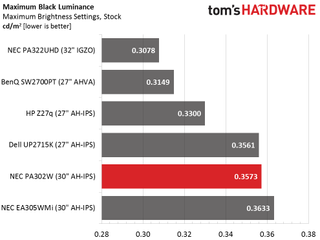
The entire group fits into a small black level window. They are all IPS panels so that makes sense. It seems that NEC’s own IGZO-based PA322UHD is the place to find the deepest blacks in this group.
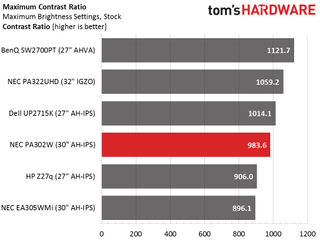
Max contrast comes pretty close to our preferred 1000:1 level. Image depth is more than adequate for the PA302W’s intended use.
Uncalibrated – Minimum Backlight Level
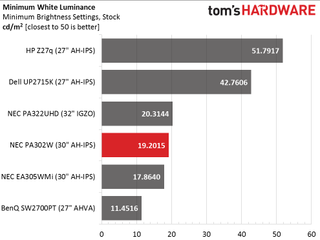
NEC favors extremely low backlight levels in its monitors. We can’t imagine a situation where 19cd/m2 would be useful. As you’ll see below, this setting has a negative effect on contrast.

Even with such a dim backlight, the PA302W remains mid-pack.
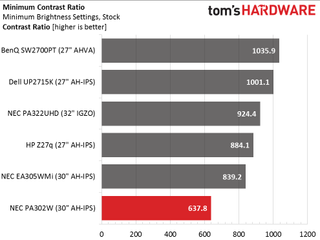
We haven’t seen a result like this in recent memory. Typically any monitor will render a similar contrast level at all backlight settings. The PA302W is an exception with its 637.8 result. However, all you have to do is up the slider to 56 (50cd/m2) to make the contrast a more consistent 976.3:1.
After Calibration to 200cd/m2
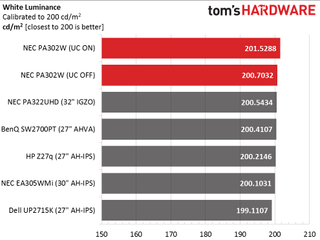
After calibration we took measurements with uniformity compensation both on and off. There are five levels, so we used number 3 for our tests. As you can see it has almost no effect on output.
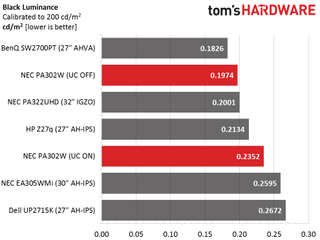
Turning UC on raises the black threshold a bit but not significantly. This should have a good effect on our final contrast numbers.

Calibration has actually raised the contrast ratio to 1016.7:1 which is a win in our book. Uniformity compensation only reduces that by 16 percent. This is the third of five settings, so numbers 4 and 5 will reduce contrast a bit more. So is the feature actually useful? Check out our surprising results on page seven to find out. It should also be noted that UC is sample specific, meaning it will have different effects on each individual monitor. Our sample appears to need only slight alterations to achieve NEC’s design goals.
ANSI Contrast Ratio
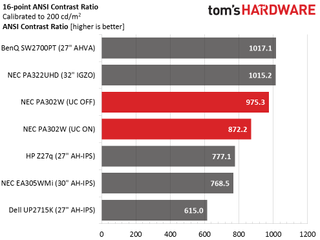
ANSI contrast is similarly affected by a UC setting of 3. A 10 percent reduction is hardly visible to the eye. So far, this looks like the best implementation of the feature we’ve seen to date.
Current page: Brightness And Contrast
Prev Page OSD Setup And Calibration Next Page Grayscale Tracking And Gamma ResponseStay On the Cutting Edge: Get the Tom's Hardware Newsletter
Join the experts who read Tom's Hardware for the inside track on enthusiast PC tech news — and have for over 25 years. We'll send breaking news and in-depth reviews of CPUs, GPUs, AI, maker hardware and more straight to your inbox.

Christian Eberle is a Contributing Editor for Tom's Hardware US. He's a veteran reviewer of A/V equipment, specializing in monitors. Christian began his obsession with tech when he built his first PC in 1991, a 286 running DOS 3.0 at a blazing 12MHz. In 2006, he undertook training from the Imaging Science Foundation in video calibration and testing and thus started a passion for precise imaging that persists to this day. He is also a professional musician with a degree from the New England Conservatory as a classical bassoonist which he used to good effect as a performer with the West Point Army Band from 1987 to 2013. He enjoys watching movies and listening to high-end audio in his custom-built home theater and can be seen riding trails near his home on a race-ready ICE VTX recumbent trike. Christian enjoys the endless summer in Florida where he lives with his wife and Chihuahua and plays with orchestras around the state.
-
Nuckles_56 That is a very impressive monitor, especially with the colour uniformity numbers, they are crazyReply -
beetlejuicegr 30 inch and 2560x1600, couldn't it be 2160p? The resolution seems low for 30 inch monitor.Reply -
fordry06 I think to do what this monitor does, making it a 4k monitor would be incredibly expensive.Reply -
Tom Griffin I wish my 27" 16:10 ASUS monitor was still alive. This monitor not only being cost prohibitive along with the previous NEC monitor review for consumers. But TBH, once you have used a NEC monitor for awhile you never EVER want to go back.Reply -
beshonk Where are all the 1440p 144hz IPS gaming monitors? there's only two on the market with horrible quality issues >.<Reply -
kittle Reply
Actually you can probably game on this monitor just fine.18154240 said:Where are all the 1440p 144hz IPS gaming monitors? there's only two on the market with horrible quality issues >.<
I have the 27" version of this one (PA270W). I play a lot of games and watch quite a bit of netflix with no issues. The color accuracy makes the games and movies look great -- exactly the way the designers and filmmakers intended them to look.
The only issue is it puts out a LOT of heat. Im guessing the 30" one will produce a bit more. -
bit_user Reply
60 Hz != 144 Hz.18170301 said:
Actually you can probably game on this monitor just fine.18154240 said:Where are all the 1440p 144hz IPS gaming monitors? -
kittle Reply
True there. my NEC only runs at 60hz. but gaming and movies work just fine18171250 said:
60 Hz != 144 Hz.18170301 said:
Actually you can probably game on this monitor just fine.18154240 said:Where are all the 1440p 144hz IPS gaming monitors?
